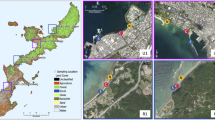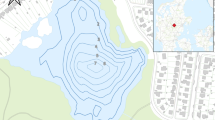Abstract
The environmental impacts of salmon net-pen aquaculture on the benthic environment were investigated at a commercial fish farm located in coastal Maine waters. This site has a sandy mud bottom and low current velocities, is subjected to episodic sediment resuspension, and way in production for 3 yr prior to this study: We examined both the increase in carbon flux to the benthos caused by the net-pen and the effects of the elevated flux on sediment biogeochemistry and the microbenthic communities. The experimental design involved the establishment of two study sites, an ambient site ca. 100 m from the net-pen and a treatment site around the pen. Sediment traps deployed 1 m above the sediment-water interface indicated that carbon flux to the benthos was increased 1-fold to 6-fold (to a maximum of 5 g m−2d−1) at the edge of the net-pen with little or no increase in carbon flux 10 m from the pen. Unlike carbon flux rates, sediment organic matter inventories showed a complex pattern of change over time. Mineral surface area, organic carbon and nitrogen, digestible protein, and sterol content were initially (April 1991) lower beneath the pen than in ambient sediments. During 1991 ambient sediment accumulated organic matter until July after which it decreased, to a low during November. In contrast, organic matter inventories of sediment beneath the pen remained low until July and then increased to a high during November. These latter gains were associated with the development of bacterial mats at the sediment-water interface. Beneath the pen, microbial and macrofaunal communities were shifted toward those commonly associated with organic enrichment but seasonal trends and storm-related resuspension events also significantly affected these sediment communities. When abundant, most epibenthic organisms were more numerous near the pen than in adjacent ambient areas. These results suggest that net-pen aquaculture can alter the benthic ecosystem in Maine Coastal waters but indicate that the effects are spatially limited.
Similar content being viewed by others
Literature Cited
Alatalo, R. V. 1981. Problems in the measurement of evenness in ecology.Oikos 37:199–204.
Aurf, J. andA. Stigebrandt. 1990. Quantitative estimates of the eutrophication effects of fish farming on fjords.Aquaculture 90:135–156.
Baker, E. T., H. B. Milburn, andD. A. Tennant. 1988. Field assessment of sediment trap efficiency under varying flow conditions.Journal of Marine Research 46:573–592.
Brown, J. R., R. J. Gowen, andD. S. McLusky. 1987. The effect of salmon farming on the benthos of a Scottish sea loch.Journal of Experimental Marine Biology and Ecology 109:39–51.
Brunauer, S., P. Emmett andE. Teller. 1938. Absorption of gases in multimolecular layers.Journal of the American Chemical Society 60:309–319.
Butman, C. A. 1986. Sediment trap biases in turbulent flows: Results of a laboratory flume study.Journal of Marine Research 44:645–693.
Butman, C. A., W. D. Grant, andK. D. Stolzenbach. 1986. Predictions of sediment trap biases in turbulent flows: A theoretical analysis based on observations from the literature.Journal of Marine Research 44:601–644.
Conover, W. J.. 1971. Practical Nonparametric Statistics. John Wiley and Sons, New York.
DeAngelis, D. L., P. J. Mulholland, A. V. Palumbo, A. D. Steinman, M. A. Huston, andJ. W. Elwood. 1989. Nutrient dynamics and food-web stability.Annual Review of Ecology and Systematics 20:71–95.
Dobbs, F. C. andR. H. Findlay. 1993. Detection of microbial-community response to disturbance, p. 347–358.In P. F. Kemp, B. F. Sherr, E. B. Sherr, and J. J. Cole (eds.). Current Methods in Aquatic Microbial Ecology. Lewis Publishers, Inc., Boca Raton, Florida.
Dobbs, F. C. andJ. B. Guckert. 1988.Callianassa trilobata (Crustacea: Thalassinidae) influences abundance of meiofauna and biomass, composition, and physiologic state of microbial communities within its burrow.Marine Ecology Progress Series 45:69–79.
Equihua, M. 1990. Fuzzy clustering of ecological data.Journal of Ecology 78:519–534.
Fauchald, K. andP. A. Jumars 1979. The diet of worms: A study of polychaete feeding guilds.Oceanography and Marine Biology Annual Review 17:193–284.
Federle, T. W., R. J. Livingston, D. A. Metter, andD. C. White. 1983. Modification of estuarine sedimentary microbiota by exclusion of epibenthic predators.Journal of Experimental Marine Biology and Ecology 73:81–94.
Findlay, R. H. andF. C. Dobbs. 1993. Quantitative description of microbial communities using lipid analysis.In P. F. Kemp, B. F. Sherr, E. B. Sherr, and J. J. Cole (eds.) Current Methods in Aquatic Microbial Ecology. Lewis Publishers, Inc., Boca Raton, Florida.
Findlay, R. H., S. L. Kim, andC. A. Butman. 1992. Colonization of freshly deposited barite and silica sediments by marine microorganisms in a laboratory flume flow.Marine Ecology Progress Series 90:73–88.
Findlay, R. H. G. M. King, andL. Watling. 1989. Efficacy of phospholipid analysis in determining microbial biomass in sediments.Applied and Environmental Microbiology 54:2888–2893.
Findlay, R. H., M. B. Trexler, J. B. Guckert, andD. C. White. 1990a. Laboratory study of disturbance in marine sediments: Response of a microbial community.Marine Ecology Progress Series 61:121–133.
Findlay, R. H., M. B. Trexler, andD. C. White. 1990b. Response of a benthic microbial community to biotic disturbance.Marine Ecology Progress Series 61:135–148.
Frid, C. L. J. andT. S. Mercer. 1989. Environmental monitoring of caged fish farming in macrotidal environments.Marine Pollution Bulletin 20:379–383.
Gowen, R. J. andN. B. Bradbury. 1987. The ecological impacts of salmonid farming in coastal waters: A review.Oceanography and Marine Biology Annual, Review 25:563–575.
Guckert, J. B., M. A. Hood, andD. C. White. 1986. Phospholipid ester-linked fatty acid profile changes during nutrient deprivation ofVibrio cholerae: Increases in thetrans/cis ratio and proportions of cyclopropyl fatty acids.Applied and Environmental Microbiology 46:930–940.
Hall, P. O. J., L. C. Anderson, O. Holby, S. Kollberg, andM.-O. Samuelsson. 1990. Chemical fluxes and mass balances in a marine fish cage farm. I. Carbon.Marine Ecology Progress Series 61:61–73.
Hill, M. O. 1973. Diversity and evenness: A unifying notation and its consequences.Ecology 54:427–432.
Holby, O. andP. O. J. Hall. 1991. Chemical fluxes and mass balances in a marine fish cage farm. II. Phosphorus.Marine Ecology Progress Series 70:263–272.
Holmer, M. andE. Kristensen. 1992. Impact of marine fish cage farming on metabolism and sulfate reduction of underlying sediments.Marine Ecology Progress Series 80:191–201.
Huang, W.-Y. andW. G. Meinschein. 1979. Sterols as ecological indicators.Geochimica et Cosmochimica Acta 44:183–188.
Johnson, A. C. 1985. The distribution of benthic macrofauna in relation to environmental and contaminant gradients in Penobscot Bay (Maine U.S.A). M.S. Thesis, Duke University, Durham, North Carolina.
Kemp, P. E. 1990. The fate of benthic bacterial production.Reviews in Aquatic Sciences 2:109–124.
Larsen, P. F., A. C. Johnson, and L. F. Doggett. 1983. Environmental benchmark studies in Casco Bay—Portland Harbor, Maine, April, 1980. National Oceanic and atmospheric Administration Technical Memorandum NMFS-F/NEC-19. Washington, D.C.
Laurén-Määttä, C., M. Granlid, S.-H. Henriksson, aandV. Koivisto. 1991. Effects of fish farming on the macrobenthos of different bottom types, p. 57–126.In T. Mäkinen (ed.), Marine Aquaculture and the Environment. Valtion Painatuskeskus OY, Helsinki.
Ludwig, J. A. andJ. F. Reynolds. 1988. Statistical Ecology, a Primer on Methods and Computing. John Wiley and Sons, New York.
Lumb, C. M. 1989. Self-pollution by Scottish salmon farms?Marine Pollution Bulletin 20:375–379.
Lumb, C. M. andS. L. Fowler. 1989. Assessing the benthic impact of fish farming, p. 75–78.In J. McManus and M. Elliott (eds.), Developments in Estuarine and Coastal Study Techniques. Olsen and Olsen, Fredenborg, Denmark.
Margulis, L., D. Chase, andR. Guerrero. 1986. Microbial communities.BioScience 36:160–170.
Mayer, L. M., S. Macko, andL. Cammen. 1988. The provenance, concentration, and nature of sedimentary organic nitrogen in the Gulf of Maine.Marine Chemistry 25:291–304.
Mayer, L. M., P. Rahaim, W. Guerin, S. A. Macko, L. Watling, andF. E. Anderson. 1985. Biological and granulometric controls on organic matter on an intertidal mudflat.Estuarine Coastal and Shelf Science 20:491–503.
Mayer, L. M., D. F. Schick, R. H. Findlay, andD. L. Rice. 1991. Effects of commercial dragging on sedimentary organic matter.Marine Environmental Research 31:249–261.
Mayer, L. M., L. L. Schick, andR. Setchell. 1986. Measurement of protein in nearshore marine sediments,Marine Ecology Progress Series 30:159–165.
McGill, R., J. W. Tukey, andW. A. Larsen. 1978. Variations of box plots.The American Statistician 32:12–16.
Messier, D. L. 1982. A comparative study of benthic community structure in the Saco and Kennebunk river estuaries Maine. M. S. Thesis, University of Maine, Orono, Maine.
Morrisey, D. J., L. Howitt, A. J. Underwood, andJ. S. Stark. 1992a. Spatial variation in soft-sediment benthos.Marine Ecology Progress Series 81:197–204.
Morrisey, D. J., A. J. Underwood, L. Howitt, andJ. S. Stark. 1992b. Temporal variation in soft-sediment benthos.Journal of Experimental marine Biology and Ecology 164:233–246.
Myers, J. L. 1979. Fundamentals of Experimental Design. Allyn and Bacon, Inc. Boston, Massachusetts.
Nickels, J. S., R. J. Bobbie, R. F. Martz, G. A. Smith, D. C. White, andN. L. Richards. 1981. Effect of silicate grain shape, structure, and location on the biomass and community structure of colonizing marine microbiota.Applied and Environmental Microbiology 41:1261–1268.
O'Connor, B. D. S., J. Costelloe, B. F. Keegan, andD. C. Rhoads. 1989. The use of REMOTS technology in monitoring coastal enrichment resulting from mariculture.Marine Pollution Bulletin 20:384–390.
Ott, L.. 1988. An Introduction to Statistical Methods and Data Analysis. PWS-KENT Publishing Company, Boston.
Packer, D. C. 1988. Community structure of macrobenthic fauna at an offshore Gulf of Maine site, with population structure analysis of the ophiuroidOphiura sarsi, and its trophic relationship to American plaice (Hippoglossoides platessoides). M.S. Thesis, University of Maine. Orono, Maine.
Pearson, T. H. andR. Rosenberg. 1978. Macrobenthic succession in relation to organic enrichment and pollution of the marine environment.Oceanography and Marine Biology Annual Review 16:229–311.
Peet, R. K. 1974. The measurement of species diversity.Annual Review of Ecology and Systematics 5:285–307.
Pillay, T. V. R. 1992. Aquaculture and the Environment. John Wiley and Sons, Inc. New York.
Podani, J. 1993. SYN-TAX PC, Computer Programs for Multivariate Data Analysis in Ecology and Systematics. Scientia Publishing, Budapest, Hungary.
Rhoads, D. C. andD. K. Young. 1970. The influence of deposit-feeding organisms on sediment stability and community trophic structure.Journal of Marine Research 28:150–178.
Simon, M. andF. Azam 1989. Protein content and protein synthesis rates of planktonic marine bacteria.Marine Ecology Progress Series 51:201–213.
Sneath, P. H. A. andR. R. Sokal. 1973. Numerical Taxonomy. Freeman, San Francisco, California.
Tsutsumi, H. andT. Kikuchi. 1983. Benthic ecology of a small cove with seasonal oxygen depletion caused organic pollution.Publications of the Amakusa Marine Biological Laboratory 7:17–40.
Underwood, A. J. 1992. Beyond BACI: The detection of environmental impacts on populations in the real, but variable, world.Journal of Experimental Marine Biology and Ecology 161:145–178.
Vestal, J. R. andD. C. White. 1989. Lipid analysis in microbial ecology.BioScience 39:535–541.
Volkman, J. K., F. T. Gillian, R. B. Johns, andG. Eglinton. 1981. Sources of neutral lipids in a temperate intertidal sediment.Geochimica et Cosmochimica Acta 45:1817–1828.
Wainright, S. 1987. Stimulation of heterotrophic microplankton production by resuspended marine sediments.Science 238:1710–1712.
Warwick, R. M. 1986. A new method for detecting pollution effects on marine macrobenthic communities.Marine Biology 92:557–562.
Warwick, R. M. 1988a. The level of taxonomic discrimination required to detect pollution effects on marine benthic communities.Marine Pollution Bulletin 19:259–268.
Warwick, R. M. 1988b. Analysis of community atributes of the marcobenthos of Frierfiord/Langesundfjord at taxonomic levels higher than species.Marine ecology Progress Series 46:167–170.
Watling, L. 1993. Functional morphology of the maphipod mandible.Journal of Natural History 27:950–960.
Weston, D. P. 1990. Quantitative examination of macrobenthic community changes along an organic enrichment gradient.Marine Ecology Progress Series 61:233–244.
White, D. C., W. M. Davis, J. S. Nickels, J. D. King, andR. J. Bobbie. 1979. Determination of the sedimentary microbial biomass by extractable lipid phosphate.Oecologia 40:51–62.
Ye, L.-X., D. A. Ritz, G. E. Fenton andM. E. Lewis. 1991. Tracing the influence on sediments of organic waste from a salmonid farm using stable isotope analysis.Journal of Experimental Marine Biology and Ecology 145:161–174.
Author information
Authors and Affiliations
Additional information
Darling Marine Center Contribution Number 279.
Rights and permissions
About this article
Cite this article
Findlay, R.H., Watling, L. & Mayer, L.M. Environmental impact of salmon net-pen culture on marine benthic communities in Maine: A case study. Estuaries 18, 145–179 (1995). https://doi.org/10.2307/1352289
Received:
Accepted:
Issue Date:
DOI: https://doi.org/10.2307/1352289




